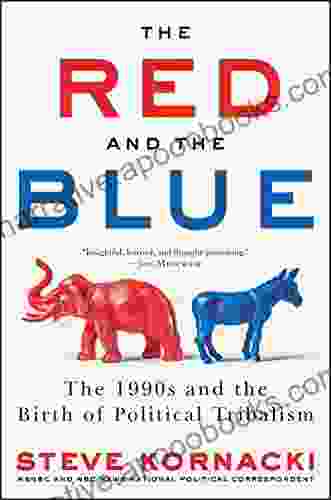The 1990s: The Birth of Political Tribalism

In the 1990s, the United States experienced a dramatic increase in political tribalism. This was due to a number of factors, including the rise of cable news, the decline of traditional media, and the increasing use of social media. As a result, Americans became more polarized in their political views, and it became more difficult to have civil discourse about important issues.
4.7 out of 5
| Language | : | English |
| File size | : | 22563 KB |
| Text-to-Speech | : | Enabled |
| Screen Reader | : | Supported |
| Enhanced typesetting | : | Enabled |
| X-Ray | : | Enabled |
| Word Wise | : | Enabled |
| Print length | : | 500 pages |
| X-Ray for textbooks | : | Enabled |
The Rise of Cable News
One of the most significant factors that contributed to the rise of political tribalism in the 1990s was the rise of cable news. In the early 1980s, there were only three major television networks: ABC, CBS, and NBC. These networks were all centrist in their political coverage, and they tried to appeal to a broad audience. However, in the 1990s, a number of new cable news channels were launched, including CNN, Fox News, and MSNBC. These channels were more partisan in their coverage, and they appealed to specific political demographics. Fox News, for example, was explicitly conservative, while MSNBC was explicitly liberal.
The rise of cable news led to a number of changes in the way that Americans consumed news. First, it allowed people to choose news sources that conformed to their own political views. This led to a decrease in exposure to opposing viewpoints, and it made it more difficult for people to have civil discourse about important issues.
Second, the rise of cable news led to an increase in the amount of time that people spent watching news. This was due in part to the fact that cable news channels were available 24 hours a day. As a result, people were more likely to be exposed to news stories that were sensational and emotionally charged. This contributed to the increase in political polarization in the 1990s.
The Decline of Traditional Media
Another factor that contributed to the rise of political tribalism in the 1990s was the decline of traditional media. In the early 1990s, newspapers and magazines were still the primary sources of news for most Americans. However, these outlets began to lose readership in the 1990s, as people increasingly turned to cable news and the internet for their news.
The decline of traditional media had a number of consequences. First, it led to a decrease in the amount of exposure that people had to opposing viewpoints. This was because traditional media outlets were more likely to present a balanced view of the news, while cable news channels and internet news sites were more likely to be partisan.
Second, the decline of traditional media led to a decrease in the amount of time that people spent reading news. This was because traditional media outlets required more time to consume than cable news or internet news sites. As a result, people were more likely to be exposed to news stories that were sensational and emotionally charged. This contributed to the increase in political polarization in the 1990s.
The Increasing Use of Social Media
The third factor that contributed to the rise of political tribalism in the 1990s was the increasing use of social media. In the early 1990s, social media was still in its infancy. However, by the end of the decade, it had become a major force in American life. Social media allowed people to connect with friends and family, share news and information, and express their opinions on a variety of issues.
The use of social media had a number of consequences for political discourse. First, it allowed people to connect with others who shared their political views. This created echo chambers, where people were only exposed to information that conformed to their own beliefs. This made it more difficult for people to have civil discourse about important issues.
Second, social media allowed people to express their opinions on a variety of issues. This was both positive and negative. On the one hand, it allowed people to voice their concerns and to challenge the status quo. On the other hand, it also allowed people to spread misinformation and hate speech. This contributed to the increase in political polarization in the 1990s.
The 1990s was a time of great change in the United States. The rise of cable news, the decline of traditional media, and the increasing use of social media all contributed to the increase in political tribalism. As a result, Americans became more polarized in their political views, and it became more difficult to have civil discourse about important issues. This trend has continued in the 21st century, and it is now one of the most pressing challenges facing American democracy.
4.7 out of 5
| Language | : | English |
| File size | : | 22563 KB |
| Text-to-Speech | : | Enabled |
| Screen Reader | : | Supported |
| Enhanced typesetting | : | Enabled |
| X-Ray | : | Enabled |
| Word Wise | : | Enabled |
| Print length | : | 500 pages |
| X-Ray for textbooks | : | Enabled |
Do you want to contribute by writing guest posts on this blog?
Please contact us and send us a resume of previous articles that you have written.
 Book
Book Novel
Novel Page
Page Chapter
Chapter Text
Text Story
Story Genre
Genre Reader
Reader Library
Library Paperback
Paperback E-book
E-book Magazine
Magazine Newspaper
Newspaper Paragraph
Paragraph Sentence
Sentence Bookmark
Bookmark Shelf
Shelf Glossary
Glossary Bibliography
Bibliography Foreword
Foreword Preface
Preface Synopsis
Synopsis Annotation
Annotation Footnote
Footnote Manuscript
Manuscript Scroll
Scroll Codex
Codex Tome
Tome Bestseller
Bestseller Classics
Classics Library card
Library card Narrative
Narrative Biography
Biography Autobiography
Autobiography Memoir
Memoir Reference
Reference Encyclopedia
Encyclopedia Alison J Reid
Alison J Reid Wil Wheaton
Wil Wheaton Korra Obidi
Korra Obidi David Mura
David Mura Stef Van Buuren
Stef Van Buuren Rita Stephan
Rita Stephan Laurie Lounsberry Mcfadden
Laurie Lounsberry Mcfadden Alison Macleod
Alison Macleod Elizabeth James
Elizabeth James Alydia Rackham
Alydia Rackham Alison Delaine
Alison Delaine Michaela J Compton
Michaela J Compton Alison Mcqueen Tokita
Alison Mcqueen Tokita Allan Gyngell
Allan Gyngell Tim Curran
Tim Curran Hoyeol Kim
Hoyeol Kim Sylvain Laforest
Sylvain Laforest Mawi Music Publishing
Mawi Music Publishing Anthony Haywood
Anthony Haywood Alice Vl
Alice Vl
Light bulbAdvertise smarter! Our strategic ad space ensures maximum exposure. Reserve your spot today!

 Nick TurnerDetecting Cyberbullying Tweets Using Machine Learning and Deep Learning: An...
Nick TurnerDetecting Cyberbullying Tweets Using Machine Learning and Deep Learning: An...
 Samuel Taylor ColeridgeKey Figures of the Wars in Iraq and Afghanistan: Biographies of War
Samuel Taylor ColeridgeKey Figures of the Wars in Iraq and Afghanistan: Biographies of War Ken SimmonsFollow ·3.4k
Ken SimmonsFollow ·3.4k Luke BlairFollow ·19.4k
Luke BlairFollow ·19.4k Denzel HayesFollow ·15.6k
Denzel HayesFollow ·15.6k Jimmy ButlerFollow ·8.8k
Jimmy ButlerFollow ·8.8k Glen PowellFollow ·10.3k
Glen PowellFollow ·10.3k Miguel de CervantesFollow ·12.8k
Miguel de CervantesFollow ·12.8k Art MitchellFollow ·2.7k
Art MitchellFollow ·2.7k Kurt VonnegutFollow ·8.2k
Kurt VonnegutFollow ·8.2k

 F. Scott Fitzgerald
F. Scott FitzgeraldUnravel the Enigmatic Murder of Mary Russell: A...
Prologue: A Grisly Discovery In the...

 Connor Mitchell
Connor MitchellLittle Quilts: Gifts from Jelly Roll Scraps
Embrace the Art...

 Harold Powell
Harold PowellPoverty Survival Hope In An American City: A Pulitzer...
A testament to the resilience of the human...

 Ray Blair
Ray BlairConfronting Global Warming: Population, Resources, and...
Global warming is one of the most pressing...

 Gary Cox
Gary CoxStyle Your Most Authentic Self and Cultivate a Mindful...
Unlock Your True...

 Caleb Long
Caleb LongEmbark on a Colorful Patchwork Adventure: Discover 20 To...
Step into the captivating world of...
4.7 out of 5
| Language | : | English |
| File size | : | 22563 KB |
| Text-to-Speech | : | Enabled |
| Screen Reader | : | Supported |
| Enhanced typesetting | : | Enabled |
| X-Ray | : | Enabled |
| Word Wise | : | Enabled |
| Print length | : | 500 pages |
| X-Ray for textbooks | : | Enabled |








